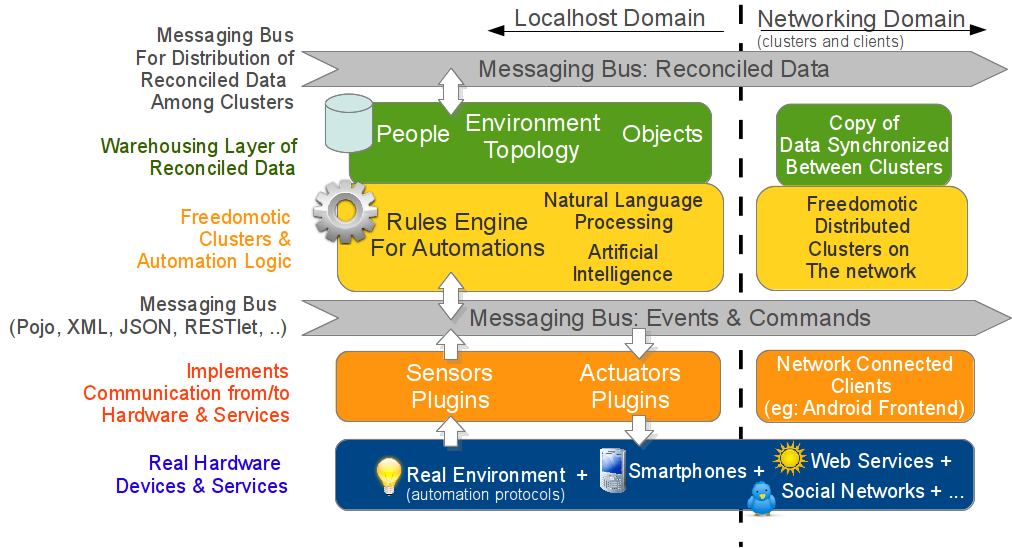
Freedomotic is composed by a core (the framework) plus some plugins.
The core part is a framework that:
1. Implements a language independent messaging system based on Enterprise Integration Pattern. From this follows you can develop in your favorite language and just exchange messages with the other software components. The aim of the messaging system is to link all software modules together in a flexible and abstract way, relating them using the concept of channels (publish-subscribe to different levels of a topics hierarchy)
2. Maintains an internal data structure representing the environment (topology, rooms connections as a graph, ...), the objects in zones and their state (on, off, open, closed, 50% dimmed, ...)
3. Creates an abstraction layer, so users and external software modules can use a high level logic like “turn on kitchen light” instead of “send to COM1 port the string #*A01AON##”. So a developer you can leverage the others plugins features at an high logical level, is just like the modules can see the same environment map as the user. All data component (environment, objects, triggers, commands) can be defined in XML and easily exchanged on the network between different nodes of the P2P Freedomotic network.
4. Provides a rules engine coupled with a natural language processing system to let the user writing automations in plain English like “if outside is dark turn on living-room light”. You can add, update and delete this automations at runtime using any human computer interface like GUIs, or even speak them.

Freedomotic plugins can add more features to the framework and can be developed and distributed as completely independent packages on our marketplace.
They usually are developed to communicate with automation hardware like X10, KNX and so on, but also graphical frontends and “web service readers” are Freedomotic plugins just as any other source of info, like webcams, text to speech engines and SMS senders.
You can also develop object plugins which are pieces of software which models the behavior of objects like lamps, doors, etc... instructing the framework on how they behave. For example a lamp object plugin tells the framework that a lamp has a boolean behavior called powered and a dimmed behavior which is represented by an integer from 0 to 100. A lamp can turn on, turn off and dimm. If dimmed becomes 0% the lamp is powered=false and if dimmed > 0% the lamp is powered=true.

Here is a diagram explaining the interaction between plugins, events+triggers+commands and Freedomotic APIs

The final goal is to define an automation which can turn on the livingroom light when it’s tea time (17 o’Clock). The scheduler plugin notifies to Freedomotic the current time (17:00 PM). A trigger named “it’s tea time” is configured to listen to all time based events. The it’s tea time trigger carries a rule inside which is “event.time.hour == 17 AND event.time.minute == 0”. When the event is received by this trigger, the rule is evaluated. If the evaluation succeed then the trigger fires, indicating that now it’s actually the time to take the tea. At this point all the corresponding automation IF (trigger: it’s tea time) THEN (command: turn on livingroom light) is loaded by the system, and the command is executed forwarding the generic request “turn on livingroom light” to the plugin which can transform it to a protocol dependent command (eg: send string ‘A01AON’ on serial port /dev/ttyUSB0).